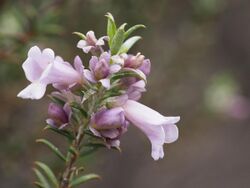Biology:Eremophila psilocalyx
| Eremophila psilocalyx | |
|---|---|

| |
| Eremophila psilocalyx leaves and flowers | |
| Scientific classification | |
| Kingdom: | Plantae |
| Clade: | Tracheophytes |
| Clade: | Angiosperms |
| Clade: | Eudicots |
| Clade: | Asterids |
| Order: | Lamiales |
| Family: | Scrophulariaceae |
| Genus: | Eremophila |
| Species: | E. psilocalyx
|
| Binomial name | |
| Eremophila psilocalyx | |
| Synonyms[1] | |
| |
Eremophila psilocalyx is a flowering plant in the figwort family, Scrophulariaceae and is endemic to Western Australia. It is an erect shrub with a broom-like shape, narrow, hooked leaves and white, pink, blue or purple flowers. It is common in the mallee country around Esperance. It was sometimes incorrectly known as Eremophila pachyphylla.
Description
Eremophila psilocalyx is an erect shrub which grows to a height of 0.8–3 m (3–10 ft) with many branches beginning at ground level. Its branches are glabrous and have raised, warty lumps, and resin secreting glands, making them sticky near their ends. The leaves are arranged alternately along the branches, narrow elliptic to lance-shaped tapering at the lower end, and with a hook at the far end. They are mostly 11–26 mm (0.4–1 in) long, 2–4 mm (0.08–0.2 in) wide, glabrous, and sticky when young.[2][3][4]
The flowers are borne singly or in pairs in leaf axils on a glabrous, sticky stalk 3–5 mm (0.1–0.2 in) long. There are 5 overlapping, cream to purple, lance-shaped sepals which are 6–11 mm (0.2–0.4 in) long and mostly glabrous. The petals are 10–20 mm (0.4–0.8 in) long and are joined at their lower end to form a tube. The petal tube is white to lilac-coloured, sometimes pink, blue or purple, and white inside with yellow-brown spots. The petal tube and lobes are glabrous apart from the inside of the lower petal lobe and the inside of the tube which have long, soft hairs. The 4 stamens are fully enclosed in the petal tube. Flowering occurs from July to October, sometimes to December and the fruits which follow are dry, oval-shaped and 3–4 mm (0.1–0.2 in) long.[2][3][4]
Taxonomy and naming
The species was first formally described by Ferdinand von Mueller in 1876 and the description was published in Fragmenta phytographiae Australiae.[5][6] The specific epithet (psilocalyx) is derived from the Ancient Greek ψῑλός (psīlós) meaning "smooth" or "bare"[7]:722 and κάλυξ (kálux) meaning "cup" or "cover"[7]:181 referring to the glabrous sepals.[3]
The species was named Eremophila pachyphylla by Ludwig Diels who was apparently unaware that the species had been described earlier.[3]
Distribution and habitat
Eremophila psilocalyx is a widespread and common species between Lake King and Balladonia[3] in the Coolgardie, Esperance Plains, Mallee and Murchison biogeographic regions[8] where it grows in a range of soils on plains, saltpans and rocky hillsides.[2][3][9]
Conservation
This species is classified as "not threatened" by the Western Australian Government Department of Parks and Wildlife.[8]
Use in horticulture
This species is not often cultivated but its prolific flowers, neat shape and the tendency of the colourful sepals to remain on the plant long after flowering make it a suitable species for wider use.[4][10] It can be propagated from cuttings but may be very slow to strike, taking up to a year to develop roots. It is more easily grown by grafting onto Myoporum rootstock and will grow in most soils in a sunny or part-shaded position. It is very drought tolerant and moderately frost resistant.[11]
References
- ↑ 1.0 1.1 "Eremophila psilocalyx". Australian Plant Census. https://biodiversity.org.au/nsl/services/apc-format/display/114996. Retrieved 6 September 2020.
- ↑ 2.0 2.1 2.2 Chinnock, R.J. (Bob) (2007). Eremophila and allied genera : a monograph of the plant family Myoporaceae (1st ed.). Dural, NSW: Rosenberg. pp. 204–206. ISBN 9781877058165.
- ↑ 3.0 3.1 3.2 3.3 3.4 3.5 Brown, Andrew; Buirchell, Bevan (2011). A field guide to the eremophilas of Western Australia (1st ed.). Hamilton Hill, W.A.: Simon Nevill Publications. p. 226. ISBN 9780980348156.
- ↑ 4.0 4.1 4.2 Archer, William (24 September 2010). "Eremophila psilocalyx". Esperance Wildflowers. http://esperancewildflowers.blogspot.com.au/2010/09/eremophila-psilocalyx-myoporaceae.html. Retrieved 2 March 2016.
- ↑ "Eremophila psilocalyx". APNI. http://id.biodiversity.org.au/name/apni/114996. Retrieved 2 March 2016.
- ↑ von Mueller, Ferdinand (1876). Fragmenta phytographiae Australiae. 10. Melbourne: Victorian Government Printer. p. 61. https://www.biodiversitylibrary.org/item/7227#page/61/mode/1up. Retrieved 2 March 2016.
- ↑ 7.0 7.1 Brown, Roland Wilbur (1956). The Composition of Scientific Words. Washington, D.C.: Smithsonian Institution Press.
- ↑ 8.0 8.1 "Eremophila psilocalyx". FloraBase. Western Australian Government Department of Parks and Wildlife. https://florabase.dpaw.wa.gov.au/browse/profile/10780.
- ↑ Paczkowska, Grazyna; Chapman, Alex R. (2000). The Western Australian flora : a descriptive catalogue. Perth: Wildflower Society of Western Australia. p. 341. ISBN 0646402439.
- ↑ "Eremophila psilocalyx". Australian Native Plants Society Australia. http://anpsa.org.au/e-psi.html. Retrieved 2 March 2016.
- ↑ Boschen, Norma; Goods, Maree; Wait, Russell (2008). Australia's eremophilas : changing gardens for a changing climate. Melbourne: Bloomings Books. p. 150. ISBN 9781876473655.
Wikidata ☰ Q15593767 entry
 |


